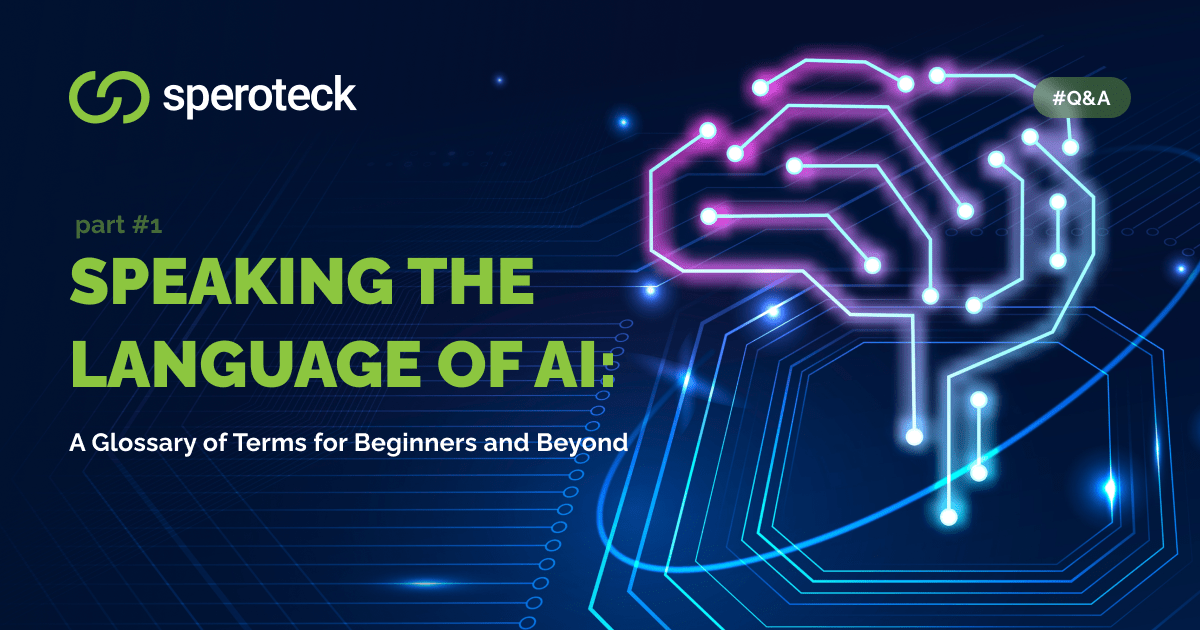
Speaking the Language of AI: A Glossary of Terms for Beginners and Beyond.
Date
Artificial intelligence is steadily taking root in our daily lives — from chatbots and search algorithms to image generation, business automation, and personalized recommendations. At the same time, the number of terms used by professionals in this field is growing just as rapidly. Whether you’re just starting your journey into AI or looking to deepen your understanding of modern technologies, this glossary will be your guide.
We’ve collected and clearly explained the key concepts from the world of AI – from basic to more advanced, so you can speak the language of AI with confidence, no matter your experience level.
A
AGI (Artificial General Intelligence) – A theoretical form of AI that can perform any intellectual task at a human level or beyond. Unlike current models, AGI can adapt to new tasks without being retrained. It remains a conceptual goal.
AI agent – An autonomous program that acts on behalf of a human to perform tasks, make decisions, and interact with external services. It can handle complex, sequential tasks, such as planning a trip, booking tickets, and selecting a hotel. AI agents are a cornerstone of future automated workflows.
AI Engine Optimization (AIEO) – A new field in digital marketing focused on optimizing content for AI models, so they better “understand”, quote, and utilize it. It’s like SEO — but for AI engines rather than search engines.
B
Big Data – Extremely large, complex, and fast-changing datasets that cannot be efficiently stored, processed, or analyzed using traditional tools like classic databases or local systems. In AI, big data is the foundation for training models — it’s how they learn patterns, train on millions of examples, and achieve high accuracy. Tools like Hadoop, Spark, Kafka, Snowflake, and Google BigQuery are commonly used.
C
Chain of Thought – A method used in AI to solve complex tasks by breaking them down into simpler, logically connected steps. Instead of generating an answer instantly, the model produces intermediate reasoning steps, making its decision-making process more transparent and often more accurate.
Context Window – The amount of text or number of tokens an AI model can process and “remember” within a single session or prompt. This defines how much context the model can retain while generating a response. Due to resource limits, each model has a maximum context window — e.g., 4K, 8K, or even over 100K tokens. Text that exceeds this limit may cause the model to “forget” older parts of the conversation.
D
Deep Learning – A subset of machine learning that uses multi-layered neural networks to automatically identify complex patterns in unstructured data (images, text, audio). It underpins modern AI systems, including speech recognition, translation, text generation, and medical image analysis.
Diffusion – A method for generating data (images, audio, text) by gradually transforming random noise into meaningful output. The model learns to first corrupt and then reconstruct data, step-by-step. This is the basis of modern image generation models like Stable Diffusion and Imagen.
Distillation – A model optimization technique where a large, powerful model (teacher) transfers its knowledge to a smaller one (student), which learns to imitate its behavior. This process enables AI to run on resource-constrained devices and powers fast, lightweight versions like GPT-4 Turbo.
E
Embedding – A method for converting words, phrases, objects, or documents into numerical vectors in a multi-dimensional space. This allows models to evaluate semantic similarity, understand context, and perform content-based searches. Good embeddings help AI “understand” meaning beyond just words.
Evals (AI Evaluation) – A system of tests and metrics used to assess the quality of an AI’s performance — accuracy, reasoning, instruction-following, ethical alignment, and more. Used both in development and deployment to ensure safety and reliability.
F
Fine-Tuning – The process of further training a pre-trained model on a specialized dataset. This adapts a general-purpose language model for specific business domains, professional fields, or stylistic requirements — like legal docs, medical reports, or tech support.
Fine-Tuning with RLHF (Reinforcement Learning from Human Feedback) – A training method that incorporates human feedback. Humans rate the model’s outputs, and these ratings guide a reward function that helps the model learn to produce more accurate, helpful, and human-aligned responses.
Foundation Model – A large-scale, general-purpose AI model trained on diverse, massive datasets (text, images, code). These models are not domain-specific and can perform various tasks out of the box or with minimal fine-tuning. Examples include GPT-4, Claude, and Gemini. Foundation models are the backbone of today’s generative AI systems.
G
GAN (Generative Adversarial Network) – An AI architecture made up of two neural networks — a generator and a discriminator — that train through competition. The generator creates data samples, and the discriminator evaluates their realism. This competitive training yields high-quality synthetic content. GANs are widely used in realistic image generation, deepfakes, fashion, and virtual content creation.
H
Hallucination – When an AI model produces information that appears factual but is actually false or fabricated. This isn’t an intentional error, but rather a byproduct of gaps in knowledge or misinterpretation of context. Hallucinations are a known issue in large language models and are especially concerning in sensitive fields like healthcare, law, or journalism.
I
Inference – The phase when a trained AI model is used to generate a result based on new input. Unlike training, inference doesn’t update the model — it applies what it has already learned. For example, when you input a question into ChatGPT and receive an answer, that’s inference. Key metrics here are speed, efficiency, and quality of response.
K
Knowledge Graph – A structured database that represents information as nodes (entities) and edges (relationships). It helps AI understand meaning, context, hierarchies, and associations — like “Paris is the capital of France.” Knowledge graphs are used in search engines, recommendation systems, personalization, and answering complex, context-dependent queries.
Mastering terminology is the key to a deeper understanding of artificial intelligence’s potential. From engaging in dialogue with technical teams to evaluating product capabilities, knowing the relevant concepts helps grasp the essence and more effectively structure processes or find better solutions. This glossary is your essential tool for navigating the dynamic AI landscape.



